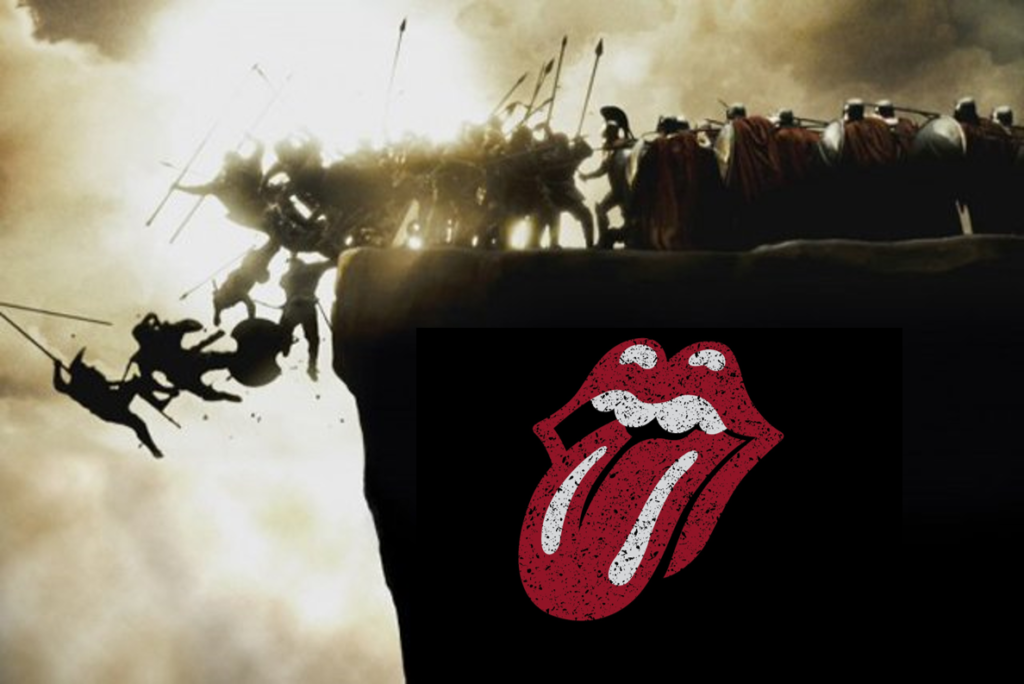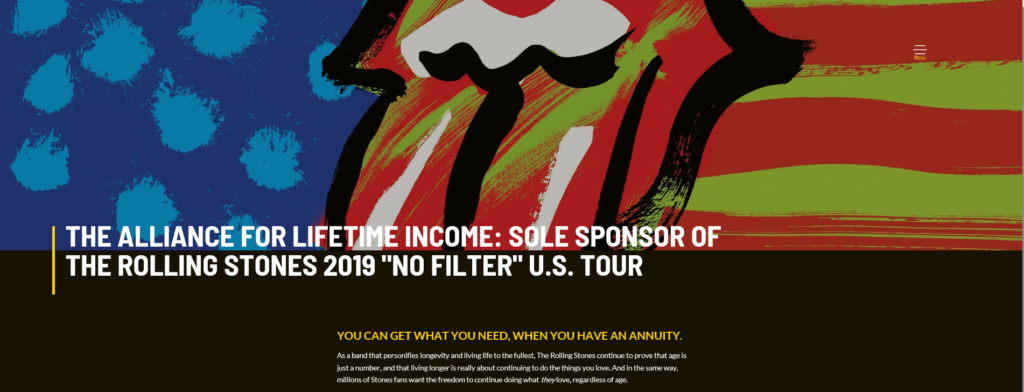
It’s another year, and despite age and the odds, the Rolling Stones are back on tour, reaping millions, while entertaining huge multi-generational crowds. This, after Mick Jagger survived heart valve surgery earlier in the year. And let’s not forget the other members of the Stones are in their seventies as well. How Keith Richards has survived the decades is nothing short of a medical miracle.
Their “No Filter” tour is now making its way throughout the U.S., but one of the least talked about aspects of this musical sojourn is the tour’s only sponsor:
The Alliance for Lifetime Income
That’s right – an association that promotes annuities. In case your financial advisor hasn’t discussed this retirement tool with you, annuities are the most conservative of the investment options this side of a savings account, designed to provide a guaranteed income to seniors. The Alliance for Lifetime Income represents conservative names like Prudential, AIG, and Goldman Sachs.
The facts are the facts. The Stones’ core audience has inevitably moved older, on a parallel path with certain radio formats that emphasize the classics. In fact, the band and its new sponsor are not shying away from this reality – in fact, they’re embracing it.
According to the New York Times’ Jeff Sommer, the Alliance puts the Stones’ “sweet spot” in-sync with their own target: 45-72 year-olds with assets ranging between $75,000-$2 million.
Sommer quotes John Covach, a Stones expert and professor of music theory:
“When fans move with the musicians, there’s no reason that advertising shouldn’t move with them.”
That’s a profound statement that somehow has never permeated sales cubicles anywhere I’ve been involved in radio with gold-based formats.
And then Jean Statler, executive director of the Alliance for Lifetime Income, echoed that observation:
“(Stones fans are) not huge investors with really a lot of money; they are the middle class. They are people who have worked hard and accumulated some savings and may have the benefit of living longer than they had ever planned, and realize they may not have enough savings to last that life span.”
For the Stones, there’s no shame in going after these advertising and marketing dollars, while most radio salespeople representing formats like Classic Rock and Classic Hits wouldn’t be caught dead putting together sales pieces touting their 50+ audience demographics.
Yet, that’s where the money is going – or has gone. But if you work in radio, you know there’s a different reality, known as the “demographic cliff.” That’s what happens to audiences that “age out” of the coveted 25-54 demographic. The way conventional wisdom works in the radio business is that stations with significant listenership at 55 years of age or older, your brand is simply not marketable or salable to advertisers.
But there are some in radio who aren’t sitting still for this. In a compelling new presentation put together by KQRS programmer, Scott Jameson, he points out some important facts about aging demographics. Scott quotes a Forbes story that points out that Americans over 50 account for $7.6 trillion in direct spending – that’s more than 80% of household wealth. And in the same deck, Merrill Lynch predicts global spending of 60+ consumers will reach the $15 billion mark by 2020. Last time I checked, that’s two quarters from now.
It’s crazy when you think that it was the Stones that once preached “What a drag it is getting old.” And now, they’re reaping the financial benefits from a sponsor that’s converted another of its famous lyrics to create their new slogan:
“You can get what you want when you have an annuity.”
Not artful, but it makes its point.

The moral of this story?
The Stones don’t care about demographics. They care about putting butts in seats and marketing that audience to advertisers. They’re not the least bit ashamed to admit their fans have become long in the tooth. In fact, they’re embracing the phenomenon while cashing in on the opportunities represented by aging Baby Boomers.
In short, Mick, Keith, and the band are interested in what has always captivated them:
MONEY.
Broadcast radio should be, too.
There’s no one else to blame for leaving a lot of money on the table.
- What To Do If Your Radio Station Goes Through A Midlife Crisis - April 25, 2025
- A 2020 Lesson?It Could All Be Gone In A Flash - April 24, 2025
- How AI Can Give Radio Personalities More…PERSONALITY - April 23, 2025




For years, the boomers have been telling their local radio stations to keep playing the oldies but nobody is listening, except for a few smart people like MeTV-FM here in Chicago. MeTV-FM is missing the one thing Boomer population thrived on in their youth…personality radio. And they’re still doing very well. Rock ‘n’ roll is still alive and baby boomers are still spending. Thanks for pointing it out.
Appreciate that, Pam. Thanks for chiming in.
Fred,
Very well written piece as always. This could have come straight out of one of my posts regarding my new music format exclusively aimed towards 55+. The Wow Factor is poised to tap into this huge arena of new ratings and revenue.
We’re on the same page.
Best,
John Sebastian
We are indeed. Thanks for the kind words, and good luck with the format.
Don’t agencies still only want 25 to 54, or really 25 to 49?
With so many stations just doing mostly transactional business that would be a hard fact to ignore.
Zeb, you are right – 25-54 IS the gold standard. And that’s the problem. It hasn’t moved in 25 years, and there are trillions (with a T) on the table radio barely gets. Lost opportunity, to be sure.
Gonna be predictably contrarian here.
Selling 55+ (and selling reach) has been something that’s been lamented by radio since I had a full head of hair. And no one has ever been successful at it – even in the days when radio paid competitively for sales and sales management. Convincing a client that they want something they say they don’t – that you just happen to have is a very tough job. I don’t care if its eyes/ears or a job candidate that doesn’t meet the criteria – occasionally someone is convinced to expand that criteria, but for the most part, headhunters and media buyers want what they want and have their parameters dictated to them.
If radio really wants to do this, the best approach is on a client by client basis, not to “tell the 55+ story better”. Find a series of 55+ customers/products, meet with the client (or at least the management supervisor at the agency) and hope that one of those meetings reveals an important need that can be filled with 55+ radio listeners. Then of course, it has to be sold, it has to work and that success leveraged into other successes.
Honestly, that’s above the skill level of today’s radio seller – it’s not a $125K selling skill – its worth 3 times that which is too rich for radio’s current blood. It would be easier to research what radio could do for 18-54s that other media can’t, go do it and let its dumbed down sales effort go sell it.
Baby boomers invented age discrimination and its interesting to see them be increasingly victimized by their creation. But the 55+ radio boulder is more likely to roll back down the hill than scale it. Maybe radio should explore how to give their customers more of what they want before trying to sell them more of what they don’t.
I was hoping to hear from you on this, Bob.
You are right that it is not advisable to sell something to clients that don’t have a need for it. No argument from me on that one.
But there are dozens of businesses, companies, brands that truly want 55+ customers. Turn on CNN for a day and watch their inventory. Radio has let agencies dictate its future, while over-focusing on “radio dollars.” As you suggest, a sales pro who can get to clients that value older demos is worth her weight in gold. Wonder how desperate the industry becomes before someone steps up with a check.
Thanks for the comment.
A big problem is the cost per sale? How many radio spots on the oldies station does it take to sell one car? Then you have the biggest 55+ advertiser, pharmaceuticals, All the required disclaimers make a radio spot impossible. That’s why you see them on TV…they can show the senior couple walking hand-in-hand on the beach while the “may cause sleeplessness, suicidal thoughts and death” legalese scrolls by. Could better salespeople make a difference? I doubt it.
Better salespeople? Dedicated salespeople to 55+ advertisers? Maybe. Maybe.
Fred:
I think you already know my thoughts on this. Radio is dropping dimes to pick up pennies in their refusal to embrace the aging Boomers.
Yup, we’ve been through this before. It tough when you continue to get evidence that could truly help radio dig its way out of this mess. Thanks, Kevin.
Usually, the argument is that 55+ Demos don’t “respond” to Advertising. It’s tougher to get a sale and not worth trying. I don’t know if that is entirely true or not. Many formats that are aimed at 18-35 year olds are failing. Many educated Boomers have abandoned terrestrial Radio because the formats offer poor content. Why not try something to bring them back?
Lorne, I think that’s “conventional wisdom” that is no longer the case. Today’s 55 year-old is a lot different (younger) than back in the 70s with a lot more income to spend. Radio woud be smart to tilt some of its sales efforts in this direction.
I agree that Radio should try to go around the Ad Agencies and sell directly to clients who want 55+. That requires maximum effort from Programming and Sales. It likely could be done, but is not being attempted.
Trying to go around the agency is a good way to get excluded from all their business. It’s really the client’s marketing department to blame. They design a campaign for 25-44 females and order the agency to buy against that target. Guess what? The buyer is not going to say to the client ”
I know this was a 25-44 female campaign but I bought the 65 and over station”. No, that’s not happening. All but the smallest advertisers, even local advertisers, have agencies. They actually don’t want to spend their business day meeting with ad reps.
In the music industry we have always had to aim new artists at the under 25 crowd because they haven’t been saturated with “must-see” stars yet. As we get older, we are more and more set in our ways. I’m sure that makes selling anything to us lots more difficult.
Bob, I wrote a blog post some time back on a research study that suggested that by age 30, most consumers are disinterested in new music. I think back to my old WRIF days in the early 80s when the “sweep spot” of the station was 12-34 year-olds. We had a very receptive audience to a lot of what was being released. It was as the audience started moving into their late 30s that we started seeing more resistance. And that’s how the Classic Rock germ started for me. Thanks for the comment.